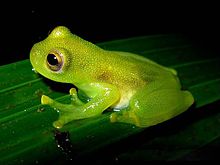Glass frog
| Glass frog | |
|---|---|

| |
| Hyalinobatrachium ruedai | |
| Scientific classification | |
| Kingdom: | |
| Phylum: | |
| Class: | |
| Order: | |
| Suborder: | |
| Family: | Centrolenidae Taylor, 1951
|
| Subfamilies | |

| |
| Distribution of Centrolenidae (in black) | |
The glass frog (or glassfrog) is the common name for the frogs of the amphibian family Centrolenidae. Most glass frogs are a lime green color. For some glass frogs the skin on the stomach area is transparent. The insides, including the heart, liver, and gastrointestinal tract can be seen through the skin. This is the reason for the common name.
Characteristics[change | change source]
Glass frogs are generally small, ranging from 1.9 to 7.6 centimetres (0.75 to 2.99 in) in length. The frog is known to eat its own young. They are green in color over most of their bodies. The skin along the lower surface of the body is translucent.[1]
Glass frogs are similar in appearance to some green frogs of the genus Eleutherodactylus and to some tree frogs of the family Hylidae. Hylid tree frogs have eyes that face to the side, whilst those of glass frogs face forward.
Distribution[change | change source]
These frogs live from southern Mexico to Panama. They are through the Andes from Venezuela and the island of Tobago to Bolivia. Some species are in the Amazon and Orinoco River basins, the Guiana Shield region, southeastern Brazil, and northern Argentina.
Biology[change | change source]
Glass frogs are mostly arboreal. They live along rivers and streams during the breeding season. Many live in montane cloud forests of Central and South America. Some species also live in Amazon and Chocóan rainforest and semi-deciduous forests.
The eggs are usually put on the leaves of trees or shrubs. The leaves hang over the running water of mountain streams, creeks, and small rivers. One species leaves its eggs over stones close to waterfalls. After they hatch, the tadpoles fall into the waters below. The tadpoles are long, with powerful tails and low fins, suited for fast flowing water.[1] Outside of the breeding season some species live in the canopy.
Genera[change | change source]

Family CENTROLENIDAE
- Subfamily Centroleninae
- Genus Centrolene Jiménez de la Espada, 1872
- Genus Chimerella Guayasamin, Castroviejo, Trueb, Ayarzagüena, Rada, Vilá, 2009
- Genus Cochranella Taylor, 1951
- Genus Espadarana Guayasamin, Castroviejo, Trueb, Ayarzagüena, Rada, Vilá, 2009
- Genus Nymphargus Cisneros-Heredia & McDiarmid, 2007
- Genus Rulyrana Guayasamin, Castroviejo, Trueb, Ayarzagüena, Rada, Vilá, 2009
- Genus Sachatamia Guayasamin, Castroviejo, Trueb, Ayarzagüena, Rada, Vilá, 2009
- Genus Teratohyla Taylor, 1951
- Genus Vitreorana Guayasamin, Castroviejo, Trueb, Ayarzagüena, Rada, Vilá, 2009
- Subfamily Hyalinobatrachinae
- Genus Celsiella Guayasamin, Castroviejo, Trueb, Ayarzagüena, Rada, Vilá, 2009
- Genus Hyalinobatrachium Ruiz-Carranza & Lynch, 1991 - "True" Glass Frogs
- Subfamily Allophryninae
Incertae sedis Ikakogi Guayasamin, Castroviejo, Trueb, Ayarzagüena, Rada, Vilá, 2009
References[change | change source]
- ↑ 1.0 1.1 Zweifel, Robert G. (1998). Cogger, H.G. & Zweifel, R.G. (ed.). Encyclopedia of Reptiles and Amphibians. San Diego: Academic Press. pp. 94–95. ISBN 0-12-178560-2.
{{cite book}}: CS1 maint: multiple names: editors list (link)
- Guayasamin, J. M., S. Castroviejo-Fisher, L. Trueb, J. Ayarzagüena, M. Rada, C. Vilá. 2009. Phylogenetic systematics of Glassfrogs (Amphibia: Centrolenidae) and their sister taxon Allophryne ruthveni. Zootaxa 2100:1-97.
- Kubicki, Brian. Ranas De Vidrio - Costa Rica - Glass Frogs (2007). In Spanish and English. ISBN 9968-927-25-2.
